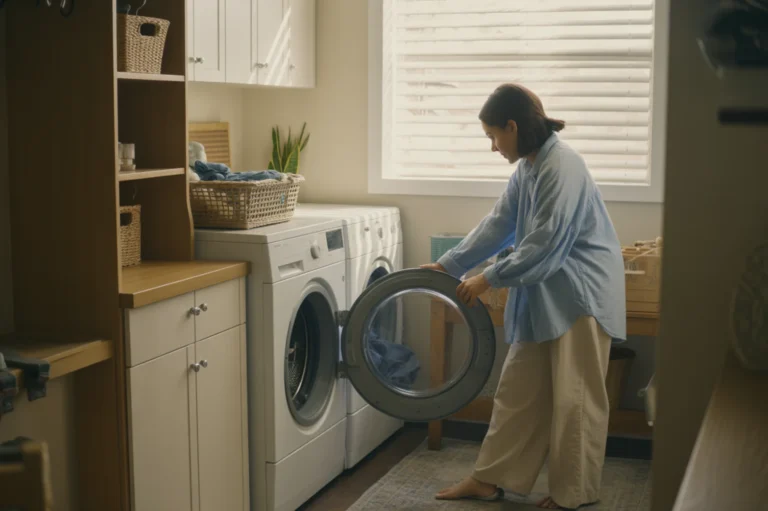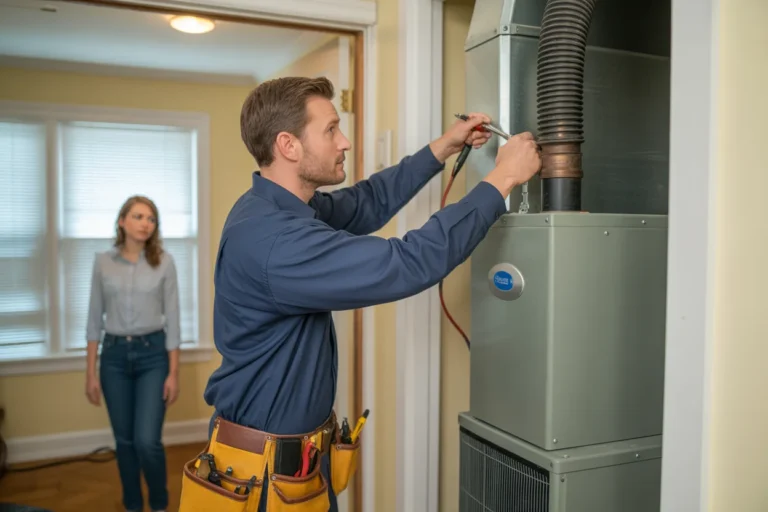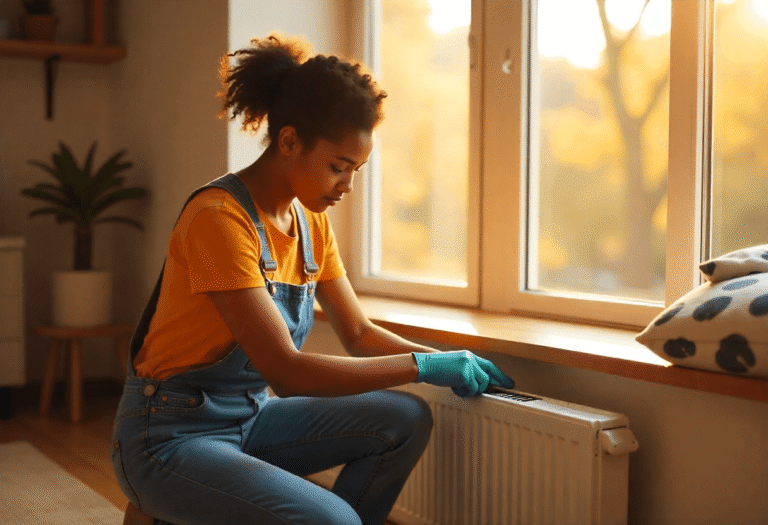Just because your home looks clean doesn’t mean the air inside is. In fact, the air in many New Jersey homes can be 2 to 5 times more polluted than what’s outside.
And the worst part is most homeowners have no idea about this.
That’s where an indoor air quality assessment comes in.
Think of it like a regular check-up for your home and HVAC system. It helps detect issues like mold spores, excess moisture, carbon monoxide, or even off-gassing from furniture or building materials.
In this blog, I will break it all down for you. You’ll learn:
- What exactly is an air quality assessment
- What it tests for and how it’s done
- How it protects your health and your HVAC system
- Signs your home might need one
- What happens after the assessment
- When to schedule it
So, let’s get started.
Key takeaways
- Indoor air can be 2-5x more polluted than outdoor air in NJ homes.
- An IAQ assessment detects invisible pollutants like mold, VOCs, and CO₂.
- Poor indoor air affects allergies, asthma, and overall health.
- NJ’s older homes and sealed winters make assessments even more important.
- IAQ inspections include air sampling, humidity checks, HVAC tests, and more.
- Signs you need testing include musty smells, stuffiness, headaches, or past water damage.
- Assessments help prevent long-term damage and protect kids, seniors, and pets.
- Testing is affordable and often includes a full report with solutions.
What is an indoor air quality assessment?
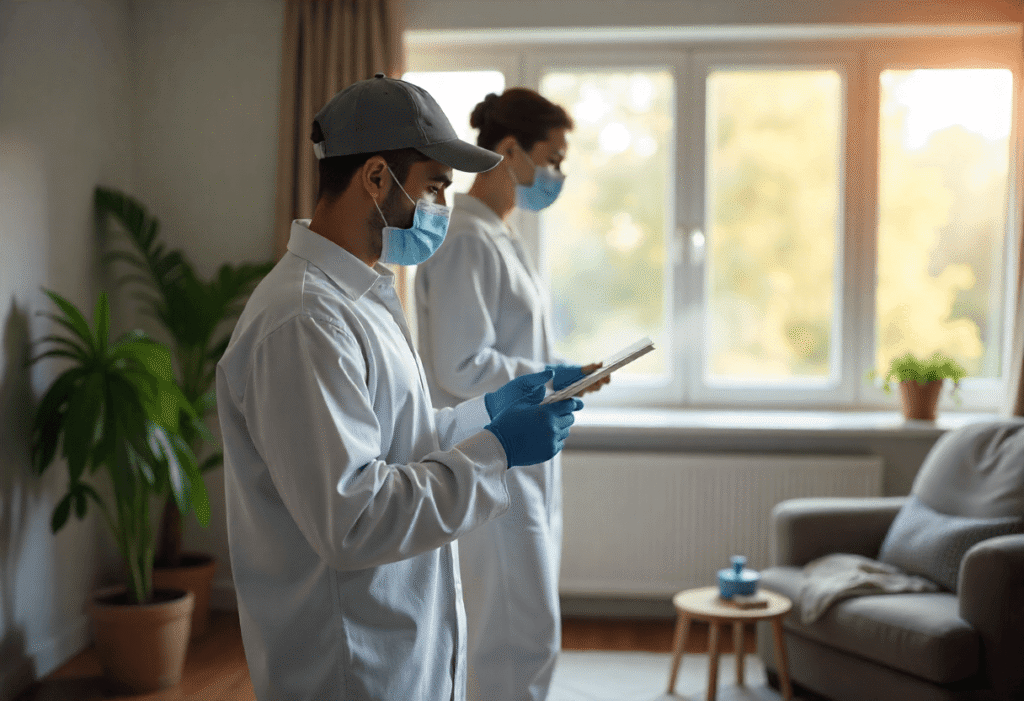
An indoor air quality or IAQ assessment is a professional evaluation of the air inside your home or building.
The goal?
To detect any invisible pollutants, moisture, or ventilation problems that could be causing discomfort, triggering allergies, or putting your health at risk.
The assessment tells you whether there are pollutants, harmful gasses, mold, or any other issues in your indoor air. Also, it checks how well your HVAC system is handling it and if anything needs attention.
In a way, it’s similar to how professionals perform environmental evaluations before major projects — like an environmental site assessment. Both help identify hidden risks early and ensure a safer, healthier environment in the long run.
Schedule Your Free Estimate Today
Contact us to improve your indoor air
quality with our expert cleaning services in NJ.
What is involved in an IAQ assessment?
A complete IAQ assessment isn’t just a quick sniff test of our HVAC filter. Instead, it’s a thorough inspection done by trained professionals with the right tools and experience.
Here’s what usually goes into it:
| Component | What It Includes | Purpose |
| Air Sampling | Dust, mold spores, VOCs, formaldehyde | Identify invisible airborne pollutants |
| Humidity & CO₂ Checks | Relative humidity, CO₂ levels, temperature | Detect moisture problems, poor ventilation |
| HVAC Inspection | Ducts, vents, filters, airflow | Ensure HVAC is functioning and ventilating properly |
| Mold/Water Damage Check | Moisture meters, thermal imaging | Find hidden leaks and mold-prone areas |
| Resident Input | Health symptoms, room-specific issues | Spot pollutant sources through lived experience |
Let’s have a closer look:
1. Air sampling for dust, mold, VOCs
A home air quality inspection majorly involves air sampling. Here, professionals use specialized sensors or lab testing kits to analyze your indoor air. They look for contaminants like:
- Particulate matter (dust, pet dander, pollen)
- Mold spores (especially in damp areas like basements or bathrooms)
- Volatile Organic Compounds (VOCs) from paints, cleaning supplies, and furniture
- Formaldehyde, ozone, and other toxic gases
These pollutants are often invisible, but they can seriously impact your health and air quality.
2. Humidity, temperature, and CO₂ measurement
Some signs of poor ventilation and moisture problems include unbalanced humidity or excess carbon dioxide. So, IAQ technicians will:
- Measure humidity levels to detect moisture problems or mold risks
- Monitor CO₂ concentration levels (if there’s high concentration, it could mean stale air is being recirculated)
- Record indoor temperature consistency, which can indicate HVAC imbalances
3. Ventilation and HVAC performance checks
Your HVAC system is central to your indoor air quality. And during an IAQ assessment, the professionals will:
- Check for restricted airflow, clogged ducts, or dirty filters
- Inspect the different air vents in your home to see how well your system exchanges indoor and outdoor air
- See if your HVAC is properly sized and ventilated for your home
4. Mold and water damage detection
If there’s a musty odor or visible signs of moisture, your technician will:
- Use moisture meters or thermal cameras to find hidden leaks
- Look for condensation or water staining around ducts, ceilings, or baseboards
- Check for active mold growth and potential sources
5. Gathering input from people living in your home
An often-overlooked step, air quality assessment consultants will talk to the residents of your home. They will ask you questions like:
- Are you or your family experiencing headaches, allergies, or fatigue?
- Do you notice strange smells, humidity, or stuffiness?
- Are symptoms worse in certain rooms or times of year?
These clues help pinpoint where air quality issues may be coming from. This is especially true for indoor air quality assessments in New Jersey where older construction or weather changes make problems harder to detect.
What are the professionals looking for during an IAQ assessment?
When we talk about an indoor air quality assessment, people assume it’s just about checking the air. But they’re far from a regular air flow check.
You see, professionals carrying out an IAQ examination in your home are trying to understand what’s in the air, how it’s moving, and whether it’s safe to breathe.
Here’s a simple breakdown of what they’re are usually looking for during an IAQ testing:
| Contaminant Type | What It Includes | Why It Is Important |
| Particles | Dust, dander, pollen, PM2.5, PM10 | They trigger allergies, asthma, breathing issues |
| VOCs | Paints, cleaners, furniture off-gassing | They cause headaches, nausea, long-term health effects |
| Gases | CO, CO₂, radon, formaldehyde | They are toxic at high levels |
| Mold & Mildew | Spores in damp areas | They cause respiratory problems and structural damage |
| Humidity & Moisture | Humid air, condensation, leaks | They lead to mold growth, affects comfort |
| Airflow / Ventilation | Stale air, blocked vents, poor exhaust | They reduce fresh air and spread pollutants |
Why is an indoor air quality assessment important?

Indoor air pollution is invisible but powerful, and the health effects can sneak up on you over time.
So, whether you’ve got mild allergies or just want to protect your family, an indoor air quality assessment helps you take control of the air in your home.
Here’s how poor air quality can impact you and why getting your air tested is essential.
1. It prevents allergies and asthma flare-ups
If you or a family member deals with allergies or asthma, poor indoor air can make things much worse.
Particles like dust, pollen, and pet dander irritate the lungs and airways, while mold spores or chemical fumes can trigger coughing, sneezing, wheezing, or full-blown asthma attacks.
An IAQ assessment helps identify exactly what’s floating in your air, so you can eliminate the source and not just treat the symptoms.
2. It eases eye, nose, and throat irritation
Ever feel like your eyes are burning or your throat feels scratchy, more so when you’ve been indoors for a while?
It might not be a cold but airborne irritants like VOCs, ozone, or stale air.
These pollutants can cause dry eyes, runny nose, sore throat, and sinus irritation even in otherwise healthy people.
So, getting your air tested helps uncover these hidden irritants before they affect your health and comfort.
3. It reduces headaches and fatigue
You might have felt foggy or tired at home but fine when you’re outside. And that’s often a red flag for poor ventilation or gas buildup, especially carbon dioxide (CO₂).
You see, low air circulation can create stale, low-oxygen environments that leave you feeling sluggish. Worse, it can give you persistent headaches.
An indoor air quality assessment helps find these ventilation issues and create a indoor space that feels fresh.
4. It prevents mold-related illnesses
Mold isn’t just ugly, it’s dangerous.
When mold spores get into your HVAC system or build up in humid or dirty air ducts, they can spread through your air and make you sick.
They can cause problems like:
- Chronic coughing
- Skin irritation
- Sinus infections
- Worsened asthma symptoms
Now, indoor environmental quality testing can pinpoint where mold is hiding, even if it’s behind walls or in your vents. This helps prevent serious health issues down the line.
5. It helps eliminate harmful gases like radon or VOCs
Some air pollutants don’t hit you right away. But over time, they take a toll on your health.
This is especially true for radon and VOCs, two commonly found gasses in indoor environments.
Here’s how these gasses affect you:
- Radon, a naturally occurring radioactive gas, is the second leading cause of lung cancer in the country.
- Formaldehyde and VOCs can lead to long-term liver, kidney, or nervous system damage with prolonged exposure.
An indoor air quality assessment is often the only way to know if these threats are present in your indoor air. Also, it tells you what steps you need to take to remove them.
Why are indoor air quality assessments especially crucial in New Jersey?
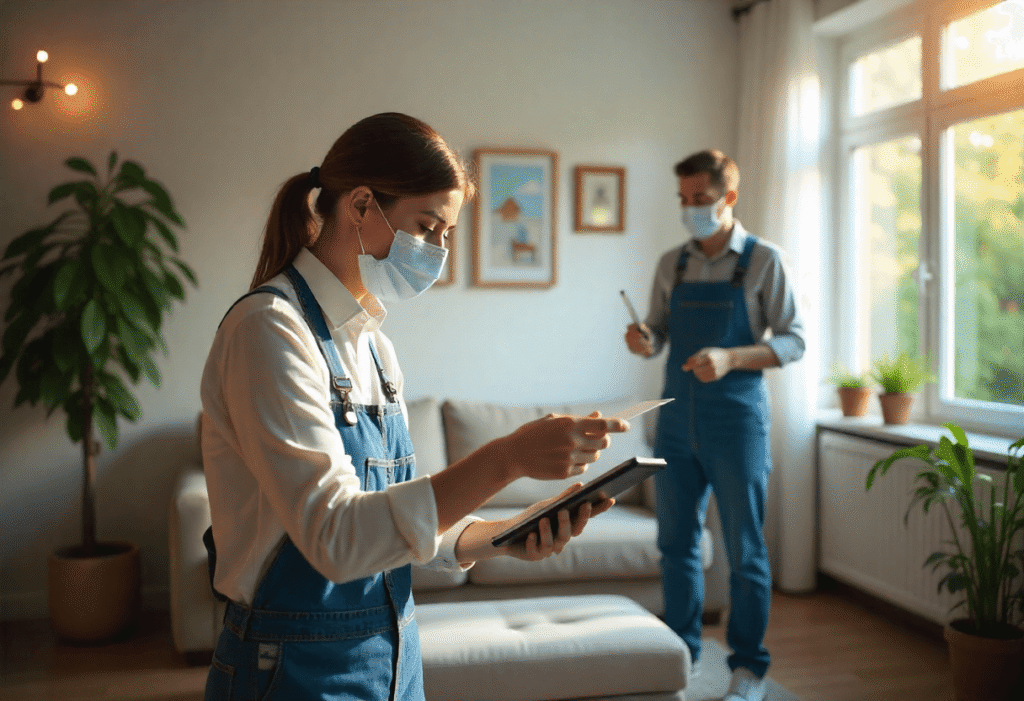
Air quality issues can happen anywhere. But in New Jersey, there are a few unique factors that make IAQ assessments even more critical.
From our long winters to older housing stock and naturally high radon levels in certain counties, homeowners in NJ face some real air quality challenges.
On top of that, reports suggest indoor VOCs are particularly higher in Jersey homes.
Overall, here’s why it’s worth taking seriously:
1. Long heating seasons (homes stay sealed for months)
New Jersey winters are long. And during those cold months, most homes are sealed tight to keep heat in.
The downside?
That also keeps pollutants, moisture, and stale air trapped inside, with nowhere to go.
Now, without good ventilation, harmful particles can build up fast, especially in high-use areas like kitchens, basements, and bedrooms.
2. Older homes have ventilation issues
Many NJ homes were built decades ago. And while the charm is real, the ductwork and ventilation often aren’t up to modern standards.
You might be dealing with:
- Leaky or clogged ducts
- Improper vent placement
- Outdated materials like flex ducting
- No mechanical ventilation in older bathrooms or attics
All of these contribute to poor airflow, moisture buildup, and increased airborne irritants.
3. Basements and crawlspaces are mold-prone
With New Jersey’s humid summers and rainy seasons, moisture settles in low-lying areas like basements and crawlspaces.
And wherever moisture collects mold follows, spreading quietly through your HVAC system or into living spaces.
So, if your basement smells musty or feels damp, that’s a red flag for mold.
An air quality assessment can help detect hidden mold spores before they become a serious health or structural issue.
4. NJ also has radon-prone zones
Certain parts of New Jersey, especially Hunterdon, Morris, Somerset, and Warren counties, are known for naturally high levels of radon. It is odorless, invisible, and deadly over time.
And the only way to know if it’s in your home is a proper IAQ and radon test.
In short, here’s why IAQ testing is crucial in NJ:
| Reason | Why It’s a Concern in NJ |
| Long Winters | Homes are sealed, trapping pollutants |
| Older Homes | Outdated or faulty ventilation systems |
| Damp Basements | High humidity encourages mold growth |
| Radon Zones | Several NJ counties have elevated radon risk |
| VOC Levels | Studies show higher indoor VOCs in NJ homes |
When should you get an indoor air quality assessment?
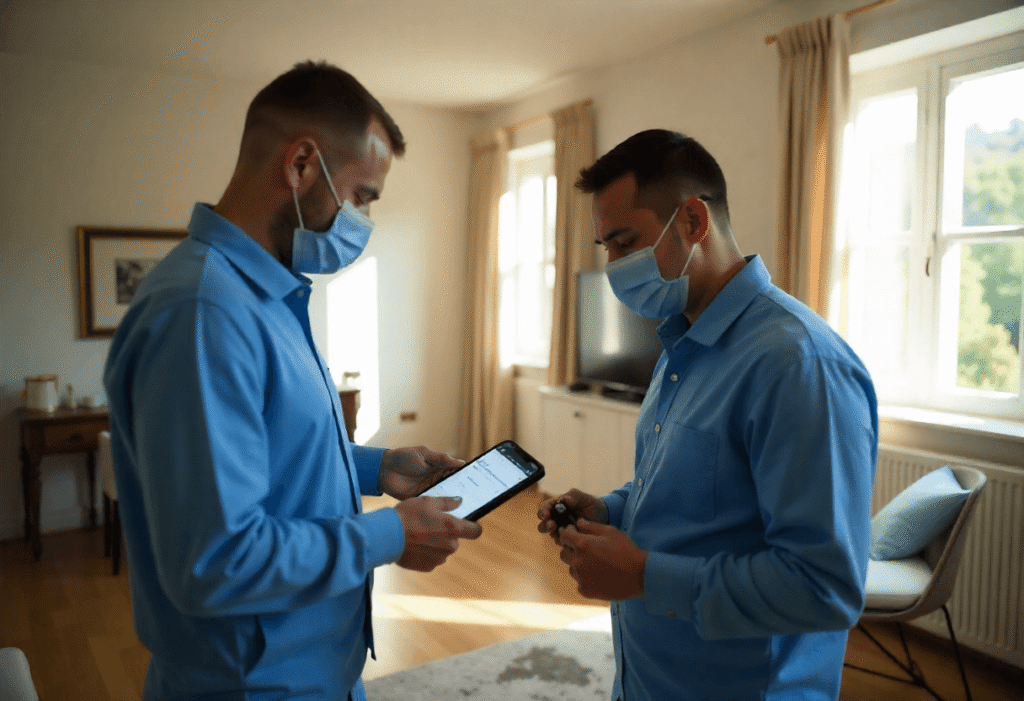
The truth is, most people don’t think about their indoor air until something starts to feel off.
But indoor air quality issues rarely fix themselves. And by the time symptoms show up, the problem may already be well-developed.
Here are some of the most common signs when you should get an IAQ assessment.
1. You notice a musty, stale, or chemical-like smell
Unusual indoor odors are often the first sign of a deeper issue.
For instance, while a musty smell can point to hidden mold or moisture, chemical or paint-like smells might be VOCs from off-gassing materials.
If your home doesn’t smell fresh and you can’t find the source, it’s time for an air quality check.
2. Residents are sneezing, coughing, or feeling unwell
If your family is experiencing allergy-like symptoms, congestion, dry throat, or headaches, especially when indoors, it could be your air.
Many airborne pollutants cause low-grade chronic irritation that we often brush off as seasonal or normal.
An IAQ assessment helps rule out what’s in the air before symptoms get worse.
3. You’ve had recent water damage, leaks, or flooding
Water damage doesn’t just destroy floors and drywall, it creates a perfect breeding ground for mold.
Even if everything looks dry, lingering humidity and hidden moisture inside walls or ducts can lead to dangerous mold growth that circulates through your air.
IAQ testing ensures you’re not breathing in mold spores.
4. Your home feels stuffy or overly humid
Poor ventilation or imbalanced humidity can make your space feel oppressive and uncomfortable.
How?
High humidity promotes mold, while low humidity dries out your skin, eyes, and sinuses.
So, if your home feels heavy, damp, or just off, an IAQ test can help detect the cause.
5. You live with someone who has allergies or asthma
When someone in the home has respiratory sensitivities, your air quality directly impacts their health and quality of life.
IAQ assessments are especially important for homes with children, seniors, or anyone with asthma, COPD, or seasonal/environmental allergies.
6. You’re renovating your home
During a renovation, your indoor environment is going through major changes, whether it’s new materials, fresh paint, HVAC upgrades, or dust from construction.
An IAQ check before or after the process helps ensure the space is safe, healthy, and ready to live in.
Schedule Your Free Estimate Today
Contact us to improve your indoor air
quality with our expert cleaning services in NJ.
In short, here’s when you should get an IAQ assessment:
| Situation | What It Might Mean |
| Musty or chemical smells | Mold or VOCs could be present |
| Frequent allergy symptoms | Airborne irritants in indoor air |
| Recent leaks or water damage | Risk of hidden mold or moisture |
| Stuffy or overly humid home | Poor ventilation or humidity issues |
| Someone has asthma/allergies | Air quality directly affects health |
| Home renovations | New materials may release VOCs |
To sum up
A professional air quality assessment isn’t just about testing the air, it makes your home safer, healthier, and more efficient.
And in a state like New Jersey where seasons shift quickly and homes vary in age and design, it’s even more important to stay ahead of it.
Need to get your indoor air tested?
Let’s talk!
At Clean Air Technologies, we’ve been helping NJ families breathe easier for over 28 years.
Whether you’re dealing with a damp basement or unexplained allergies, our expert IAQ assessments give you the answers and the solutions.
You might also want to read: How To Get Rid Of Mold In Air Ducts?
FAQs about indoor air quality assessments
What exactly is tested during an indoor air quality (IAQ) assessment?
An IAQ assessment checks for a variety of indoor air pollutants and environmental conditions, including:
- Dust and particulate matter (PM2.5, PM10)
- Mold spores
- Volatile Organic Compounds (VOCs) from paints, cleaners, furniture
- Carbon monoxide (CO) and carbon dioxide (CO₂)
- Formaldehyde and radon (in high-risk areas)
- Humidity levels
- Airflow and ventilation performance
How do I know if I need an air quality test in my home?
You should consider an IAQ assessment if:
- You notice musty, chemical, or stale smells indoors
- People in the home are experiencing allergies, asthma, or headaches
- You’ve had water damage, leaks, or high humidity
- Your home feels stuffy, humid, or overly dry
- Someone in the household has respiratory sensitivities
- You’re buying, selling, or renovating your home
- You live in an older NJ home with poor ventilation or unknown ductwork condition
Even if you don’t have obvious symptoms, a proactive test can catch hidden issues early.
How much does an indoor air quality assessment cost in New Jersey?
The cost typically ranges from $250 to $600 in New Jersey, depending on the:
- Size of your home
- Number of tests performed (e.g., mold, VOCs, radon)
- Whether lab analysis is included
- Level of detail in the final report
Some companies also offer bundled services with HVAC cleaning, duct inspections, or remediation recommendations
Is mold always visible or can it be hidden in the air?
Mold can absolutely be hidden. In many cases, mold spores are airborne long before you see visible growth on walls or ceilings.
An IAQ assessment can detect elevated mold spore levels and help trace them back to hidden water damage, leaks, or damp areas like basements, crawlspaces, or ductwork.
Are indoor air quality issues dangerous for kids and pets?
Yes, children, seniors, and pets are more sensitive to indoor air pollutants due to their smaller lung capacity and faster breathing rates.
Poor IAQ can cause or worsen:
- Asthma
- Allergies
- Skin and eye irritation
- Fatigue
- Respiratory infections
An IAQ assessment helps ensure your home is safe for every member of the family, including kids and pets.
Will I get a report after an IAQ test?
Yes, after the assessment, you’ll typically receive a detailed report showing:
- What contaminants were detected
- Whether the levels are safe or concerning
- Source identification (if possible)
- Recommended next steps, such as air purification, mold remediation, or improved ventilation
Good IAQ providers also offer post-remediation testing to confirm the problem has been resolved.
How long does a typical air quality assessment take?
Most residential IAQ assessments take between 1 to 3 hours, depending on your home’s size and the complexity of the issue.
Lab-based tests (like mold or VOC samples) might require a few extra days for results, but basic testing like humidity, CO₂, and particulate levels can be read on-site.
Does the EPA recommend indoor air quality testing?
While the EPA doesn’t mandate home air quality tests, it strongly encourages assessments when:
- Indoor air pollution is suspected
- Residents are experiencing symptoms
- There’s a history of moisture problems or poor ventilation
- Homes are in radon-prone zones (like many parts of New Jersey)
The EPA also provides guidelines for improving IAQ through ventilation, humidity control, and pollutant source reduction.
Will an air purifier fix all air quality issues?
Not always.
While HEPA air purifiers can reduce particles like dust, pollen, and some allergens, they won’t fix:
- Mold behind walls
- VOCs from off-gassing materials
- Poor ventilation
- High humidity
- Radon or CO leaks
An IAQ assessment helps you identify the root cause so you’re not just masking symptoms with a purifier.
Is indoor air really more polluted than outdoor air?
Yes, studies show indoor air can be 2 to 5 times more polluted than outdoor air, especially in well-sealed or energy-efficient homes that lack proper ventilation.
This is because indoor air traps:
- Dust
- VOCs
- Cooking byproducts
- Mold spores
- Pet dander
- Smoke
- Cleaning chemicals
This is why testing and ventilation are both crucial for maintaining healthy air indoors.


